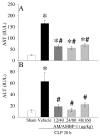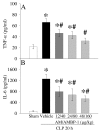Reversing established sepsis in rats with human vasoactive hormone adrenomedullin and its binding protein
- PMID: 19009024
- PMCID: PMC2581607
- DOI: 10.2119/molmed.2008.00092
Reversing established sepsis in rats with human vasoactive hormone adrenomedullin and its binding protein
Abstract
We recently demonstrated that early administration of rat adrenomedullin (AM), a vasoactive peptide, in combination with its binding protein (human AMBP-1) produces various beneficial effects in sepsis. Human AM is a 52-amino acid peptide, but rat AM differs from human AM, having only 50 amino acid residues, with two amino acid deletions and six substitutions. It remains unknown whether a combination of human AM and human AMBP-1 (AM/AMBP-1) is also beneficial in sepsis and, if so, whether human AM/AMBP-1 reverses established sepsis in rats. To test the effects of human AM/AMBP-1, we induced sepsis in male adult rats by cecal ligation and puncture (CLP). At 10 h after CLP (i.e., severe sepsis), human AM (12-48 microg/kg body weight) was administered in combination with human AMBP-1 (40-160 microg/kg body weight). Vehicle-treated animals received a nonspecific human plasma protein (albumin). Blood and intestinal samples were collected at 20 h for various measurements. In additional groups of septic animals, the gangrenous cecum was surgically excised at 20 h after CLP. The 10-day survival was recorded. Our results showed that tissue injury, as evidenced by increased levels of transaminases and lactate, was present at 20 h after CLP. Proinflammatory cytokines tumor necrosis factor-alpha and interleukin-6 were significantly elevated. Gut barrier dysfunction, manifested by increased mucosal permeability to hydrophilic macromolecules and increased bacterial translocation to mesenteric lymph nodes, also occurred at 20 h after CLP. Administration of human AM/AMBP-1 in established sepsis markedly attenuated tissue injury, reduced proinflammatory cytokine levels, ameliorated intestinal-barrier dysfunction, and improved the survival rate from 47% to 67%-80%. Thus, human AM/AMBP-1 can be further developed as a safe and effective therapy for patients with established sepsis.
Figures





Similar articles
-
Human adrenomedullin and its binding protein ameliorate sepsis-induced organ injury and mortality in jaundiced rats.Peptides. 2010 May;31(5):872-7. doi: 10.1016/j.peptides.2010.01.010. Epub 2010 Feb 2. Peptides. 2010. PMID: 20132852 Free PMC article.
-
Mechanisms of the beneficial effect of adrenomedullin and adrenomedullin-binding protein-1 in sepsis: down-regulation of proinflammatory cytokines.Crit Care Med. 2002 Dec;30(12):2729-35. doi: 10.1097/00003246-200212000-00018. Crit Care Med. 2002. PMID: 12483065
-
Adrenomedullin and adrenomedullin-binding protein-1 downregulate inflammatory cytokines and attenuate tissue injury after gut ischemia-reperfusion.Surgery. 2007 Feb;141(2):245-53. doi: 10.1016/j.surg.2006.05.017. Epub 2006 Sep 14. Surgery. 2007. PMID: 17263982
-
The critical role of adrenomedullin and its binding protein, AMBP-1, in neuroprotection.Biol Chem. 2012 May;393(6):429-39. doi: 10.1515/hsz-2012-0103. Biol Chem. 2012. PMID: 22628306 Review.
-
Adrenomedullin and adrenomedullin binding protein-1: their role in the septic response.J Surg Res. 2003 Feb;109(2):175-81. doi: 10.1016/s0022-4804(02)00086-0. J Surg Res. 2003. PMID: 12643861 Review.
Cited by
-
Adrenomedullin binding improves catecholamine responsiveness and kidney function in resuscitated murine septic shock.Intensive Care Med Exp. 2013 Dec;1(1):21. doi: 10.1186/2197-425X-1-2. Epub 2013 Oct 29. Intensive Care Med Exp. 2013. PMID: 26266790 Free PMC article.
-
Human ghrelin ameliorates organ injury and improves survival after radiation injury combined with severe sepsis.Mol Med. 2009 Nov-Dec;15(11-12):407-14. doi: 10.2119/molmed.2009.00100. Epub 2009 Sep 18. Mol Med. 2009. PMID: 19779631 Free PMC article.
-
Inhibition of lipogenesis reduces inflammation and organ injury in sepsis.J Surg Res. 2016 Jan;200(1):242-9. doi: 10.1016/j.jss.2015.06.059. Epub 2015 Jul 2. J Surg Res. 2016. PMID: 26216747 Free PMC article.
-
Adrenomedullin Therapy in Moderate to Severe COVID-19.Biomedicines. 2022 Feb 24;10(3):533. doi: 10.3390/biomedicines10030533. Biomedicines. 2022. PMID: 35327335 Free PMC article. Review.
-
Combination of adrenomedullin with its binding protein accelerates cutaneous wound healing.PLoS One. 2015 Mar 17;10(3):e0120225. doi: 10.1371/journal.pone.0120225. eCollection 2015. PLoS One. 2015. PMID: 25781901 Free PMC article.
References
-
- Howell G, Tisherman SA. Management of sepsis. Surg Clin North Am. 2006;86:1523–39. - PubMed
-
- Powers J, Jacobi J. Pharmacologic treatment related to severe sepsis. AACN Adv Crit Care. 2006;17:423–32. - PubMed
-
- Jenkins I. Evidence-based sepsis therapy: a hospitalist perspective. J Hosp Med. 2006;1:285–95. - PubMed
-
- Bernard GR, et al. Efficacy and safety of recombinant human activated protein C for severe sepsis. N Engl J Med. 2001;344:699–709. - PubMed
Publication types
MeSH terms
Substances
LinkOut - more resources
Full Text Sources
Medical
Miscellaneous

